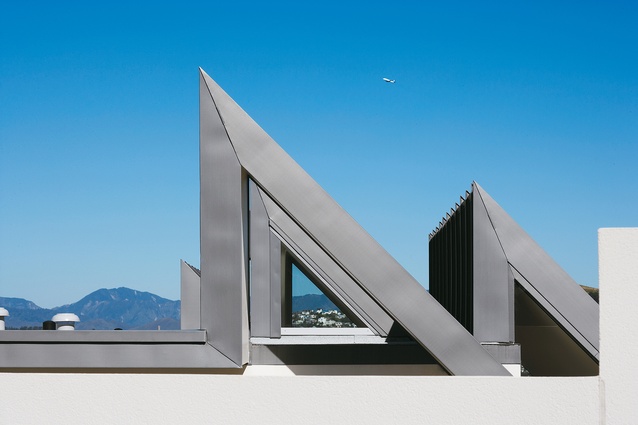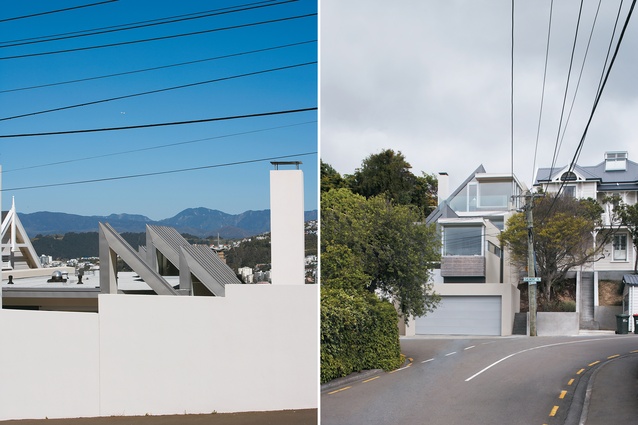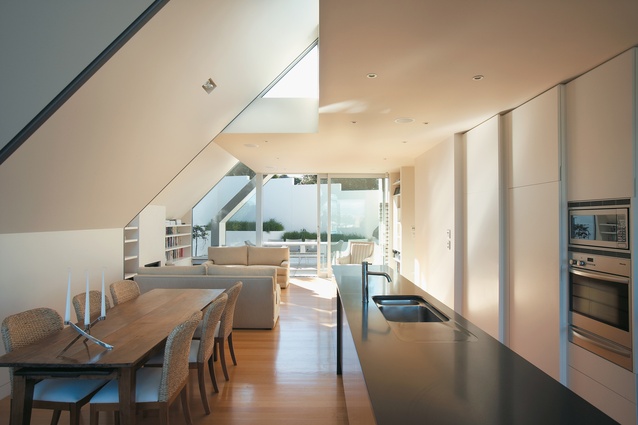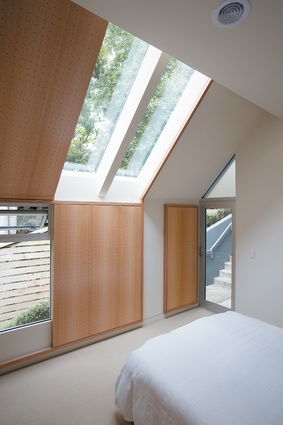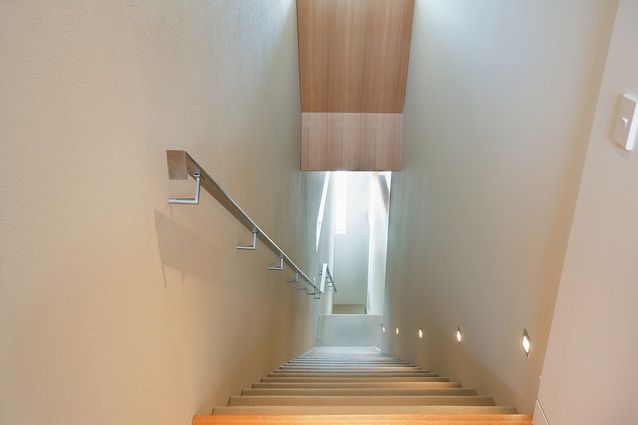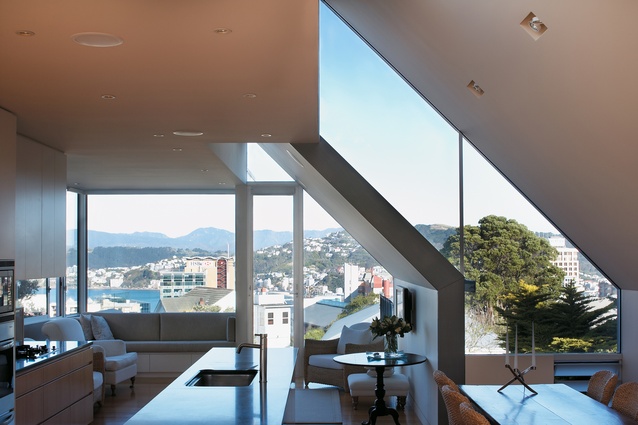Houses Revisited: Crafty rooster
From the archives: Visit a home on a steep Wellington site, in an old part of town, where Parsonson Architects have designed a clever townhouse.
The north end of Kelburn, between The Terrace and the top of the Botanic Gardens, has long been a locus classicus of Wellington’s haute bourgeoisie. It’s a handsome precinct of steep streets and fine homes, many dating back at least a century. The neighbourhood wears its history well – as comfortably as a QC inhabits a discretely pin-striped bespoke suit. There are terrific views over the city and across the harbour to Oriental Bay, in comparison a rather louche district, sun-struck and sensual (for Wellington, that is).
Although it is one of the finest urban neighbourhoods in New Zealand, this bit of Kelburn has always seemed to me slightly melancholy. This may just be projection on my part, a tristesse born of envy (I grew up in Wellington, but a long way from this favoured slope). Or perhaps the pleasant downer should be attributed to topography and orientation – to east-facing Kelburn’s premature loss of afternoon sun. Or it might be a response to the proximity of the dead. This bit of Kelburn is just up the hill from the Bolton Street Cemetery, or, at least, from what remains of the dead heart of Victorian Wellington after it was despoiled to make space for (an admittedly very well-designed) motorway.
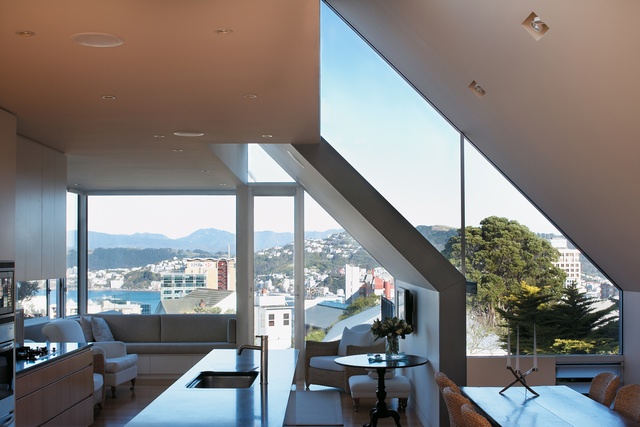
So: a place not short of gravitas or resonance, deserving of a careful response from the contemporary architect – although not always getting it. However, this house, which steps down a narrow site bounded by streets above and below, is very well done. Gerald Parsonson is a thoughtful architect, considered and considerate in his approach. But, in his case, care should not be confused with caution.
The west elevation of this house offers a ‘what the …’ surprise to anyone who has toiled uphill to the Botanic Gardens’ eastern border. Poking up above a block wall is a spiky roof line that sticks it to both gabled traditionalism and flat roofed-modernism. It may even be interpreted, more abstractly, as a geometric salute to local topography, or as a reference to a more distant typology. Gerald Parsonson acknowledges the resemblance of the roof, with its zinc cladding pinched into sharp peaks, to the ‘Canterbury pickle’ roofs of the Sixties and Seventies.
This roof is an arresting element of the house, but it’s not a product of whimsy or wilfulness. Rather, it’s a response to the site and the brief (and height-to-boundary diktats). The roof is an ‘enabler’, one might say, which allows for views through the house on its upper living level, and for the admittance of natural light into the top of the house. The provision of views and light does not come at the cost of privacy, either for the occupants of this house, or for the neighbours.
The clients were concerned, Parsonson says, that the house be subservient to the existing villa on the north side, a listed building designed by John Campbell (1857-1942) who was New Zealand’s first Government Architect from 1909-1922. For decades the villa was the sole occupant of a corner site which now accommodates, on either side of Campbell’s original building, an Athfield-designed house and this Parsonson-designed one. As well as instructing their architect to pay sufficient deference to the Campbell villa the clients also wanted Parsonson to take account of the villa’s garden, with its large pohutukawa.
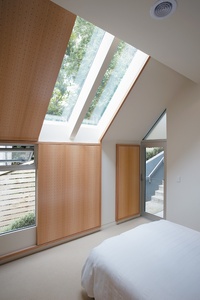
The top level of the 4-bedroom house (or 3-bedroom plus study), is a light-filled platform that gives out onto a small courtyard, which is sheltered by the western boundary wall. This is a charming space in itself, and also serves to extend the living platform. You can sit out on the terrace and look right through the house, east to Mt Victoria above Oriental Bay. A stair leads down the north side of the house to the lower bedroom floor and eventually to the garage at the foot of the site. The stair has a lot of slope to negotiate and is steep enough to be vertigo-inducing, although small windows into the garden of the neighbouring villa bring relief on the downward journey.
The bedrooms are comfortable spaces, in which the architect has deployed a simple and restrained palette of materials and colours. It is in these rooms that the townhouse nature of the building is most apparent: the clients’ children are at university now, and the design of the house reflects the family’s changed needs and circumstances.
Gerald Parsonson says the design and construction of this house was an “intense” process, but if so, it is one that has led to a most competent and interesting resolution. The clients, who have a strong interest in architecture, have had the confidence to countenance a design which is, in significant part, unorthodox and even surprising.
Click here to see more Houses Revisited. And sign up to our email newsletters to receive Houses Revisited straight to your inbox.

